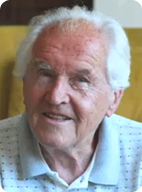

HP Memories
Foreword by John Minck
Mr. . HP Labs - Zvonko FazarincOnce upon a time, long ago, in the Land of High Tech, and the Valley called Silicon, there was a magical Kingdom known to all as Hewlett Packard. Out of this kingdom for years and years sprung the most fanciful wonders of instrumentation and computers and printers and such. All of HP’s many provinces (manufacturing divisions) contributed to the continuous outpouring of these useful inventions, with their bright young inventors working diligently to satisfy their customers. But in the heart of the Kingdom, high on a Page Mill hill, in a building with a funny-looking roof like an upside-down sawtooth, there dwelled an even higher technology clan, which was called Hewlett Packard Laboratories. It was presided over by a Wizard of Legend, and some repute, whose name was Barney. Barney was at once charming and brilliant and at times, cantankerous. The sole mission of this HPL was to push out the frontiers of science and technology to the very limits of knowledge and practice. All of their accomplishments were then sent to the HP provinces to fashion into important electronic products for the betterment of mankind, (and some profit to the kingdom, which was their Objective #1). OK, the HP work culture of the last half of the 20th Century wasn’t really all that magical. We in the HP “provinces” were usually in some awe of the brilliance and knowledge of all of those who worked in the “Ivory Tower.” Certainly, Barney Oliver, and later Don Hammond and Joel Birnbaum, who led that clan of remarkable scientists and engineers were in the genius class of an already world-class company. And certainly, most of us wondered just how life would be to come to work every day and face the real chance that Barney would drop by your desk to see how your project was doing, and perhaps to check on your technical reasoning? We had images of that management retreat cartoon which showed Barney in a forum, responding to a question from the floor, “Now look here, young man...when I said you were a stupid sonofabitch, I didn't mean anything personal.” One of those effective and illustrious scientists who labored for decades in that environment was Zvonko Fazarinc, and we are all anxious to read his career memoir to find out just exactly how daily life was in that hotbed of ideas and top tier science? Zvonko came to HP after early telecommunications system design with HP equipment in Yugoslavia, and recommendations from his friend Dr. France Rode, already at HP, as well as the local HP Salesman. Getting to the United States involved first the doctorate program at Stanford, although he wasn’t planning to actually move to HP. His project work in HP Labs resulted in some seminal accomplishments, which make fascinating reading, because of his modest presentation. Probably the most significant work was triggered by what appeared to be a short-term project to fix the Step-Recovery-Diode process. This remarkable diode technology had become massively important in many instruments; stabilizing signal generators, used as a local oscillator in Vector Network Analyzers, down-conversion in microwave counters, etc, etc. It was generating unwanted spurious output signals, which came along with the desired comb of harmonic frequencies. His mission was set by Barney and Hewlett with a very serious time line, and a dread of not being able to solve it quickly. He did solve it quickly, using the newly introduced HP 2116A computer which had been configured beyond its original purpose of controlling instruments, to handle data processing. But much more significantly, Zvonko envisioned how to computer-model electronic circuits in a powerful simulation software project that he achieved with HPCAD. This achievement came along right at the critical time in circuit design technologies because of the rapid onrush of semiconductor components across the board. His basic ideas even ended up in commercial products such as Spice®. And, as always, the fertile minds of Barney and Hewlett were pushing Paul Stoft to challenge Zvonko and his Lab associates to find new projects that would meet future customer measurement needs. Perhaps Zvonko’s most memorable project was to assemble and compile the most significant life writings of Barney after his death. I like Zvonko as a friend because I can always ask him physics questions like issues on the expansion of the cosmos after the Big Bang, or strange particles like the Quark, and get answers that are in my range of comprehension. This memoir tells us commoners that it was a grand pleasure to spend a career in HP Labs.
John Minck
|
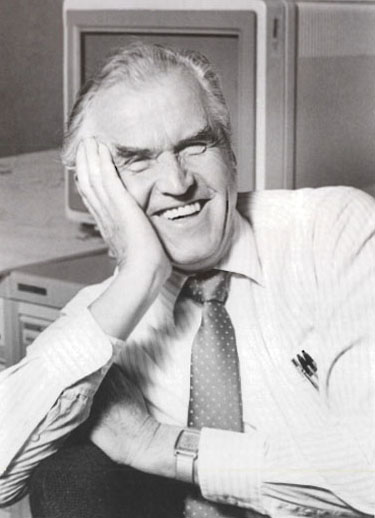 |
My Association with HP,
by Zvonko Fazarinc
Introduction
John Minck and Marc Mislanghe deserve credit for their patient reminders of my promise to reminisce about my HP years. While those were very enjoyable days in my life they also opened the path to a future I had never before imagined. It is therefore high time for me to employ the little memory I have left to say a few words about HP people whom I was privileged to know and who shaped the company’s culture.
Before coming to the US
I must note that I knew about and used (and liked) HP equipment long before I knew where it was manufactured. From 1953 to 1960 I was working in Ljubljana, Slovenia in their National Communications Institute. We were developing and building microwave radio links for the Yugoslavian telephone companies. These were intended to compensate for the missing ground lines and to connect the numerous Adriatic islands with the mainland.
Since 1948 when President Tito successfully seceded from the Russian domination, Yugoslavia established many links with the Western World. It was not uncommon for our Institute to buy and use HP microwave measuring instruments. Their European representative, Mr. Zweny, lived in Brussels, Belgium at that time. During his numerous visits to our Institute he would tell us about this wonderful Hewlett-Packard company where, “everything was done right.” What impressed us the most was that HP practiced profit sharing with their employees. This was something that Tito’s regime was promising us as soon as we completed the buildup of a socialist state.
Why did I come to the US?
When my upcoming teaching assignment in Ljubljana demanded an advanced degree I made a few attempts to earn it in Slovenia. But interference of my R&D management duties called for me to distance myself from the Institute. Having used Fred Terman’s book during my studies I was familiar with Stanford, which seemed distant enough from my place of employment. So in 1960, I came to Stanford to earn my PhD in electrical engineering. When I met Fred Terman and thanked him for writing his book on electronics he was upset that Slovenia also translated it without paying him royalties. He calmed down when I told him that I used the English edition.
Stanford and Palo Alto were completely new cultures for me and my family at that time. A kind fellow student took me for a ride around the Stanford area, and when we entered Page Mill Road, I was reminded of the familiar HP address. Commenting about this induced my student-friend for a quick tour of the HP 1501 Page Mill facility, which was then a topic of pride in my letters to colleagues back in Slovenia.
My PhD research project was assigned by Professor Bracewell, who was a global expert on radio astronomy and antenna technology. I was thereby involved in the construction of a Stanford radio interferometer, and during that period I received a lesson in university-industry cooperation, which was essentially missing back in Europe. Instead of a budget for procurement of parts, I was given a name to call at HP whenever I needed resistors, capacitors, or pc-boards. When I later met with other professors visiting HP Laboratories I understood why Silicon Valley was born in this particular area. The mutual trust between the academic and industrial world mandated it.
Why did I stay in the US?
During our 4 years of life in California, my wife, my two children and I became quite attached to it, despite the meager $2,100 a year research assistantship, out of which we were paying all our expenses including tuition. During our time here, we experienced some serious difficulties during my wife’s illness, but the kindness of friends and others made a powerful impression on us. The thought of never seeing California again, which was indicated by the existing exchange rate at that time was unbearable.
Having made no obligations to return to Slovenia, we decided to make the US our new home. My friend and colleague Dr. France Rode, who is also a Slovenian and who found us upon our arrival to Palo Alto, worked in the Frequency and Time Division of HP, and confirmed my vision of this company. Ignoring the offer from my mentor Professor Ronald Bracewell and another one from the UC Berkeley astronomy department, I sent out a single job application to HP. The personnel department decided to send me to HP Labs for an interview.
How did I meet Barney Oliver?
My interview at HP in the fall of 1964 was with my potential new boss, Paul Stoft, and a few of his engineers. That apparently went well and I was later taken to Barney Oliver’s office. He wanted to hear my ideas for utilizing the knowledge acquired in designing the Stanford radio telescope to possible new HP instrumentation line. Much of our interchange focused on the contrast of Barney’s ideas to those of Bracewell about the methods to search for extraterrestrial intelligence. I believe that this specific exchange induced Barney to take me along to the IEEE general convention in New York later that year. That was the year he served as president of IEEE, and one of his personal goals was to publically outline his SETI ideas. They were not just rough ideas but he had refined them enough that the SETI institute later became the recipient of Barney’s unique designs for search instrumentation and of his significant monetary support.
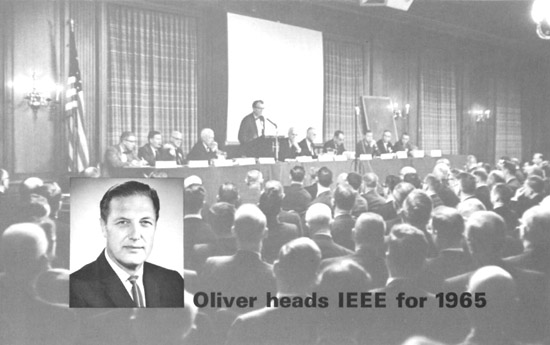 |
| Photo from MEASURE Magazine, January 1965 Courtesy of the Hewlett Packard Company |
R&D in Slovenia versus R&D in HP Labs
The improved availability of capital equipment was apparent already during my lab work at Stanford. The fact that my radio interferometer project had a budget of 150 thousand dollars was overwhelming, remembering how difficult it was to get an approval for buying the first couple of transistors back in Slovenia. These having been point contact devices did not last very long and the electron tubes seemed to have an assured future. Not so in HP Labs where all designs were done with transistors. Fortunately in my Stanford work I had changed my opinion on transistors and designed all signal processing circuitry with them. So I was ready to start immediately on my proposed microvolt meter at HP.
The relationship with HP Lab colleagues was easily established and everybody was very helpful to me. I was impressed with the proliferation of ideas for new instruments and for solutions to design problems. In Slovenia the kind of links that shaped the relationship with my colleagues required special conditions not present in HP Labs. There we started work at 6AM and the first thing we had to do was to start a fire in the tiled stove. The joint anticipation of warmth from the tiles against which we were leaning created special bonds that still live on.
Socialism at HP?
It was customary for Bill Hewlett and Dave Packard to officially meet with groups of new HP Labs employees. During my turn Dave Packard asked me how I liked it so far at HP? I told him enthusiastically that I found more socialism at HP than I did back in Yugoslavia. He was amused but suggested that I call it something other than socialism. At that time I did not perceive any distinction between the national political parties and did not know anything about Senator McCarthy’s devisive hearings on communism in the US.
But, as a matter of fact, I did start to notice the difference between the two political parties only during the President Reagan’s era. But the daily visits of Bill and Dave to the laboratory, during which they were able to ask questions of the nature, “Is your grandma any better?” left unforgettable impressions on me. Also, occasions like Bill Hewlett talking to the cleaning lady about her family, impressed me with an HP work culture that matched the “socialist” theory we were learning back in Yugoslavia, but never saw in practice.
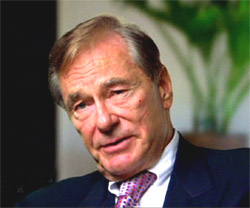 |
Tom Perkins |
My first project was a microwave microvolt meter whose prototype had to be demonstrated to the southern California military industry. I had no ideas how to travel or visit customers or make contact with the Field Engineers at Neely, so Barney asked his assistant Tom Perkins to go with me. Yes, this was the now famous Venture Capitalist, who at that time worked for Barney Oliver.
His talents were obvious in all respects, and the one that left a strong impression with me was his suggestion that we dine at a famous Los Angeles restaurant known to cater to the business society, and very difficult to get into without reservation. The line of potential customers was so long that I lost all hope of getting in but Tom spoke to a waiter and in no time we had one of the best tables there. It was no surprise when Tom was soon promoted to Dave Packard’s office. In one of his recent interviews Tom gave Dave Packard credit for being the first VC from whom he learned everything he knows. From our trip, we learned that there was not enough customer interest to pursue the meter project and I quickly learned the importance of idea marketability.
From instruments to computers
In the early sixties, the common question during coffee breaks was, “which instrument are you working on?” But a new trend had started showing up in HP Labs after Paul Stoft hired Kay Magleby, who was the only one among us who knew something about computers. The idea was to connect measuring instruments together and process the measurement results into data that was something closer to the needs of the user.
I remember Dave questioning the value of hiring a computer guy into the instrument lab. So Paul Stoft made such a good case for the instrument controller idea that Dave strongly considered buying DEC. This was revealed to me years later by Bill Hewlett. The injection of computer expertise into the lab soon became noticeable during coffee breaks, particularly after we had the first minicomputer prototype installed in the lab. Soon somebody procured a four-pass Fortran compiler, and more than one compilation a day was considered exceptional.
How can the computer help an instrument company?
At the end of 1968, the Rockaway Division was almost ready to ship (with a prayer) their Telemetry FM Signal Generator series 3205A, when spurious signals that had plagued them earlier, recurred again. That same problem existed for years with all signal generators based on the step-recovery diode frequency multiplier. So they decided to ask HP Labs for help. Paul Stoft and Barney Oliver charged me with the task of solving the problem quickly and in a way that the product could be readied for shipment with minimum intervention to the hardware. To prepare me, I was given 37 long articles on the topic. These had all already been studied by the Rockaway engineers and I was told that many microwave engineers and some professors from MIT and Stanford who had studied the problem would also be interested in learning my solution?
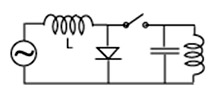 |
| Circuit model for step-recovery-diode |
Facing this intimidating deadline, I asked myself why did I not stay at Stanford or join UC Berkeley? I also concluded that the only chance for me to solve the problem was to use a new tool that had not been tried before. Computer modeling came to mind but the commercially available circuit analysis programs ran on $2000 an hour CDC 6400 computers and were doing only steady state analysis. This excluded any non-linear circuits, which included the step-recovery diode case. The early HP 2116A minicomputer standing in the corner of the lab all of a sudden became the hope for saving my job. Out of the fairly complex circuit diagram I singled out the step-recovery diode module because it was present in all signal generators that were beset with the spurious signal problem. It was fairly easy to write down the few discrete equations for the simple circuit shown in the adjacent picture except for the step recovery diode. A short discussion with John Moll resulted in a diode model that was a short when forward biased and a capacitor when reverse biased.
How lucky can one get?
Without getting into details of how the currents and voltages of the circuit were displayed with a strip-chart recorder let me just say that the very first run of the circuit model produced the spurious signals in addition to the desired output. By changing the inductor value of L and the diode capacitance, the frequency of the spurious signal could be changed and it was immediately obvious that a damping of this combination would eliminate the problem for a slight penalty in efficiency. It was difficult to hide my excitement when I ran into Barney’s office and showed him the results of the simulation on pieces of a strip chart. He was quickly convinced and my next task was to reproduce the solution on the actual 3205A signal generator. A piece of poly-iron placed near the short transmission line, which served as the inductor L in the actual instrument did the trick and the shipment of the product could commence with just a three month delay.
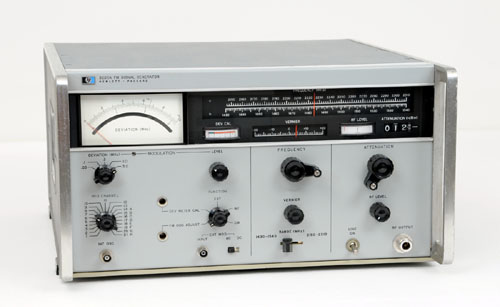
More Information |
The HP 3205A |
Can we do circuit designs on the 2100A minicomputer?
This first successful circuit simulation on the minicomputer evoked in me the vision of a computer becoming one of the instruments on the circuit designer’s desk. Time domain seemed the only reasonable choice that would accept non-linear circuits and from which one could get also frequency domain data with Fourier transformation if so desired. The reverse, of course, is not possible. In 1969, Paul Stoft urged me to write an internal 91 page report entitled, “A Method for Simulation and Analysis of Linear and Non-linear Networks on a Small Computer,” which was supposed to bring other HP engineers on board. In the meantime the HP 2100A minicomputer was introduced and was shown on a few specific examples to be computation time competitive with IBM 360/50 at a 35 times lower cost. The comparison was published in the paper, “Minicomputer as a circuit design tool,” which I wrote for the Simulation Councils, Inc. in 1971. About that time, HP also began to successfully market a Time Share version of the HP 2100A system. Along with a commercial software called BASIC, it trained a generation of young engineers.
Making the computer friendlier to circuit designers
It was unfortunate that HPCAD, as we called our software on the 2100A minicomputer, required each circuit analysis program to be written by hand. Despite the instructions provided in my internal report I was very busy helping engineers in many HP divisions convert their circuits into the strange language that the computer could understand. It soon became obvious that an automation of the process was imminent. Paul Stoft understood the problem and hired Ken Van Bree from MIT who knew how to get from a list of nodal connections of circuit elements to a set of Kirchhoff’s equations. With his help and with the help of a couple of computer assembly language programmers we succeeded in squeezing HPCAD into the precious 16,000 bytes of core memory of the 2100A minicomputer. Having a transistor model and a capacity of 100 components HPCAD became a usable tool inside HP and at a number of universities around the country.
Why did HPCAD die?
In the late 1960s the software sources written at HP were still considered a free gift to the customer for buying HP hardware. But Paul Stoft began to appreciate the value of software and would not allow me to give it to the universities. Because of this we then probably lost a number of free improvements to HPCAD needed to make it into a marketable product. Besides analyzing and displaying transients and providing frequency domain information on linear and non-linear circuits, HPCAD was able to optionally write out all the differential equations for the submitted circuit to the delight of circuit theorists and computer scientists. Therefore HPCAD could have benefitted from a broad distribution of the source code just like UNIX did. When Professor Newton from Berkeley publicly gave credit to HPCAD for the ideas later implemented in SPICE® circuit analysis program, HP did receive at least some recognition.
John Young wants to improve HP oscilloscope reputation
One day I was approached by John Young, who succeeded Bill Hewlett as CEO, to do something about the bad reputation of HP oscilloscopes. Paul Stoft sent me to our oscilloscope division in Colorado Springs to gain an understanding of their views and thoughts on the problem. Jointly we soon agreed that we needed a drastic new approach to this classical instrument and the Labs would cooperate to come up with new ideas. After gathering a few smarty’s from the lab into a number of vivid discussions of the ways to tame the HP oscilloscope, we soon concluded that a digital approach was the answer. But the 400MHz requirement instantly eliminated a fully digital oscilloscope because the analog to digital converters were far behind such capability at that time.
The next best possibility was to digitally control the otherwise analog oscilloscope. But the combination of high frequency analog circuits with digital logic on single chips sent chills down our spines. There was no lack of ideas on how to design the human interface. Barney Oliver felt that we should have only one rotary knob for the adjustments of all individually selected functions. I felt that this would be too drastic a change for a classical instrument but it was not easy to quarrel with Barney. Our argument that, “the world may not be ready for a one key piano with a pitch selector,” finally convinced Barney and we quickly completed a computer simulation of the new oscilloscope with a proposed front panel containing controls familiar to customers.
Bill Hewlett's kind toughness
Invited to the demonstration of a possible future oscilloscope front panel, behind which was a big computer, were the division and R&D managers of the Colorado Springs and other HP units. After a fairly enthusiastic acceptance of the proposal, Bill Hewlett asked me to have the prototype ready in one year. Knowing that we had to design 14 integrated circuits containing 400MHz analog hardware with digitally controlled parameters, none of which has ever been tried before, I vehemently objected and pointed out that we were not talking about a calculator. Bill Hewlett just smiled politely and walked away saying “Zvonko, if you have something better to work on just let me know!”
The proposed controller of the new oscilloscope was to perform automatic calibration of time and amplitude scales among other vital functions and there was no question that we needed the former designer of the HP35 calculator processor, France Rode, who joined my laboratory at that point. Fortunately Mr. Hewlett’s deadline of one year was not firm enough to harm me after we took a few years to complete the prototype of the 1980 oscilloscope, which received the “Product of the Year Award” by the “Electronic Products Magazine,” for 1982.
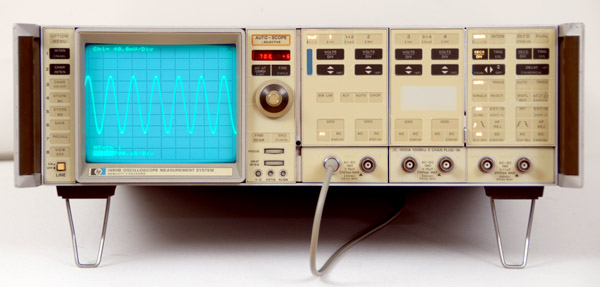
More Information |
The HP 1980A |
GPS
After inheriting him from the Microwave Division with recommendations of John Young, Ralph Eschenbach made me aware of the GPS project pursued by the Department of Defense. While the actual positioning signals were encoded and accessible only to military equipment, we had tried the clear channel with ten time’s coarser accuracy for navigation. We built and then tested our prototype on the Bay Area streets including San Francisco. While one could tell from the data plotted on the map which side of the freeway we were driving, the San Francisco city plots appeared almost random.
Ralph soon found an excellent match by “moving” the city of San Francisco to the correct geographic position. Our city map was obviously offset and we thus had a good case to appear before the highest HP authority. I was given the chance to present our results and a proposal to the next Board of Directors meeting. After the meeting Dave Packard told me in presence of Barney Oliver to see him personally should anybody stand in the way of this project, to which Barney responded, “Zvonko, you have now a direct line to God!”
While trying to involve a manufacturing division into participation in my program, the actual satellite constellation was still far from being complete. After the space shuttle disaster the GPS product marketability seemed too far in the future. This and the vital pursuit of the computer business induced John Young to suggest that the GPS project be cancelled. The vision of a GPS pocket device matched that of the HP pocket calculator years before, and it was one of the most difficult tasks for me to tell my enthusiastic lab crew the bad news. Sometime later we sold the prototype and the documentation to Trimble Navigation, which became the prime supplier of GPS devices to the Desert Storm in 1991, and a global leader in that superb technology.
Back to communications
During my early days at HP I had inquired why HP was not engaged in communications systems, with so much microwave talent present? Bill Hewlett explained to me that the communication companies (ATT in particular) were such good customers of HP instruments that we would not want to offend them by invading their turf. But with the digital era opening new turf in communications, I was allowed to start fooling around with some exciting ideas that my engineers wanted to work on. Joel Birnbaum, who was recruited from IBM for his RISC expertise, replaced Barney Oliver as the R&D VP, and was quite supportive of this activity despite the hard time we, the so-called “Old HP-ites,” gave him.
The resentment of the first “not-at home-grown-manager” was responsible for such behavior until we properly understood HP’s grave needs in the field of computer technology. Joel turned out to be one of my best bosses and soon the Building 3 at 1501 Page Mill Road was engulfed in infrared communication links between all engineers within each of the floors and with a microwave link connecting the UNIX servers between floors. New ideas of our top management about what I should be doing ended my exciting digital communication R&D, whose analog version I left behind in Slovenia.
On loan to Stanford
In July, 1984, CEO John Young decided that I should be the first HP representative in the Center for Integrated Systems (CIS) at Stanford. HP was namely one of the 20 companies that saw value in equipping the Stanford School of Engineering with modern facilities that would prepare their students for immediate utility in the industry. No such return on capital investments was seen by the University for doing the same, yet the end result was definitely motivating to both sides to a tune of one million dollars for each industrial partner.
After the CIS building was completed and equipped, each industrial contributor was to send their representative to CIS for participation in R&D. I was probably selected because I was teaching a course in semiconductor principles and circuit modeling, on and off since 1972. I had continued to enjoy the new-found freedom from lab management to prepare the lecture material. The computer simulations done earlier, saw new opportunities with the advent of color displays and powerful workstations.
Soon I was wheeling an HP color workstation around the campus into which I had programmed a few topics that were difficult for the students to comprehend. These were mostly problems commonly described by partial differential equations. My enthusiasm matched that of my students and during my two year term at CIS, I experimented with many new ideas that became valuable in my next assignment.
 |
| HP 9000 Workstation of the late 1980s |
During the eighties when the European Union was being created, there was much talk about the undesirability of international companies. HP had a considerable stake in Europe and the so called “European Presence Strategy” was created to assure HP’s desirability in Europe. One of the issues in this strategy was the need to assure Europeans that HP is not only interested in manufacturing capabilities of Europeans but also in their academic affairs. I was chosen to join our European Management Center in Geneva in January 1987 with the task of helping them address this particular topic. Because I had my workstation HP9000 loaded with some interesting simulations and our new powerful color UNIX workstation 320 just became available, we scheduled appearances at all important universities throughout Europe. The topic of my two hour presentations was the use of computers in education. The fact that it was demonstrated on HP workstations was an extra benefit to the sales force, which in every country provided superb support and preparations for my appearances.
In the two and a half years of my residence in Geneva I lectured at 70 universities in all, European countries as well as in Turkey and Israel. During these visits I met a few professors who were interested in pursuing the creation of educational software and I saw the opportunity to form a consortium of universities with them. We applied to the European community for funding and because cooperative efforts between European countries were seen as highly desirable, I was able to finance the consortium of six top schools in Europe. HP joined in with donations of workstations to each of these schools. The project CoLoS (acronym for Conceptual Learning of Science) as we named it still lives today and was honored by the European Academic Software Award for Excellence in Physics in 1994.
My last visit with Barney Oliver
In 1990 I retired for the first time but was soon called back as a Senior Science Advisor to the VP of R&D. During that time I often visited Barney Oliver and pushed him to publish some of the work he often wrote down. Instead he usually passed them to Don Hammond, Len Cutler, me and a few other scientifically minded friends, and then just filed them away. Much of that material was at least PhD thesis caliber. When I asked him again shortly before his death to get his filed papers published, he promised to do it as soon as he finished his current book, “Modern English Misusage,” in which he aired his frustrations, often expressed very directly to presenters.
Bill Hewlett said in his memorial address that Barney, as all brilliant people, had opinions on everything, and for which he was not averse to express in a forceful manner. Even his family was not spared his brilliance and once when he did not show up for a scheduled meeting I called his wife. Upon learning that he missed an appointment she exclaimed, “Thank God, he is finally losing his mind!” Unfortunately Barney did not quite finish his language book but was far enough along to be completed by his friends.
At his memorial I committed to collect his papers and publish them in a book. I approached Dave Packard for approving HP expenditure for this project when he jokingly remarked that Barney was asking for money even from his grave. Joel Birnbaum eventually financed the project and gave me time off for doing it. Barney’s genius rises majestically from the over-400 pages of his notes and a few published papers. Those included the paper written jointly at Bell Labs, with J.R.Pierce and C.E.Shannon in which they laid ground for the digital technology. I am told by someone who knew people at Murray Hill, that their local legend and reports from contemporaries, tells us that in those years when those three geniuses, Pierce, Shannon and Barney roamed the halls of Bell Labs, that there was no stronger brain trust in the world.
His SETI contributions are collected in the book and so are his personal opinions on a variety of topics from atomic energy to social issues. Dave Packard praised the clarity of Barney’s papers at his memorial and attributed them to his communication skills supported by the reverence for grammar instilled in him by his school-teacher mother at an early age.
Time for an active retirement
The HP profit sharing policy, which impressed me even before I came to the United States, was certainly a contributor to the standard of living of employees of this unique company. The employee stock purchase plan provided for the future financial security of many employees and their families. Performance recognitions added their share of wealth to many of us who were fortunate to work for the Hewlett-Packard Company. For me this work consisted of opportunities to participate in a number of challenging projects whose content made my workdays enjoyable. I am therefore expressing my gratitude to HP for enabling me to enjoy my retirement in a style never imagined in my wildest dreams.
Under such motivating conditions I often heed the advice of Barney Oliver to never stop learning and to always nurture a chosen expertise. Discrete mathematics is what I put to use in papers covering a broad field of physics guided by Albert’s (Einstein) advice to make things as simple as possible but not simpler. I intend to continue doing this as long as reputable publications will accept my papers and so far my luck has not yet run out.
Palo Alto, CA
June, 2012
Zvonko Fazarinc
Curator Note As we edited Zvonko's memoir, he showed us a funny tribute to Steve Budai, on the occasion of Steve leaving HP Labs for his next job. Steve was their exceptional computer maintenance engineer. It was written and presented by Ken Poulton, whose permission we obtained to publish it here. We think it shows the humorous working culture of some VERY creative people. After the farewell party, Zvonko thought Dave Packard would get a kick out of it, so he sent it along with this transmittal memo. By the way, it is a striking coincidence that the medieval style of John Minck's Foreword was written several months before Ken Poulton's (biblical) tribute was discovered.
HP’s Legendary Farewell Parties, Ken Poulton
|
